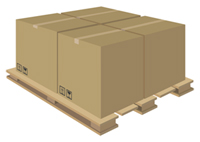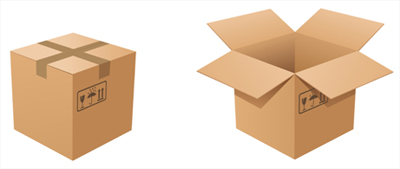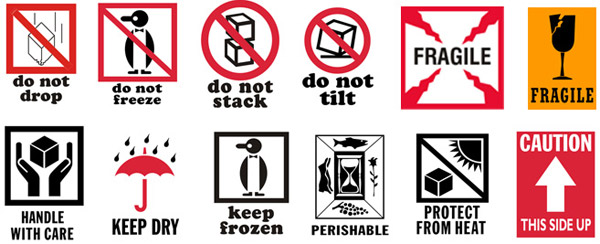

Below are the most common hazards in distribution and they must always be considered when preparing your shipment.
Occurs when the package shifts or comes in contact with other packages or material handling equipment during sorting and other shipping operations. They can also be the result of improper or insufficient internal packaging that does not prevent the contents from shifting, resulting in the product being damaged or the package failing to contain the product.
Occurs when external forces are applied to the sides, faces or corners of a package. Stacking, shock, vibration, material handling equipment and tie-down straps all generate compression forces that may result in package or product damage. Proper packaging offers the necessary level of protection against these forces.
High and low atmospheric pressures are not restricted to air transit and can have a dramatic effect on some products or packages. High and low humidity can result in condensation or corrosion, and it can greatly reduce the stiffness and compression resistance of paper-based products. Temperature extremes globally can range from -80º F to +160º F and can dramatically affect the performance characteristics of packaging material. Other common environ-mental exposures include, but are not limited to, dirt, dust, odors and precipitation. If a product or package would be considered damaged if exposed to these hazards, then the shipper must take extra measures to ensure the package can protect the shipment from these known hazards.
Proper cushioning can reduce damage caused by the shock incurred during shipment handling. It is important to note that your shipment will most likely be handled with a forklift at some point during distribution. Proper packaging must be able to protect the contents from the drops and impacts commonly associated with handling operations.
Occurs during handling and transportation as a result of impacts with forklifts, racks, containers, floors and other shipments. Proper cushioning can reduce damage caused by shock. Most products will require some level of shock protection to prevent damage during normal distribution.
Occurs in transport vehicles like trucks, planes or ships and on virtually anything else that moves, such as forklifts or conveyor belts. Proper cushioning can absorb and reduce the negative effects vibration can have on your product.

Palletizing freight helps multi-piece shipments remain together and provides increased protection from damage. Each pallet, including its contents, is.
Loose items, such as boxes or containers that have not been secured to a pallet, are considered non-palletized freight. Each loose item is considered one piece.
Pallets are portable rigid platforms used to consolidate shipments and allow for ease of freight movement. Quality pallets are commonly made of either wood or plastic and can weigh between 20 and 70 lbs. Pallets should be large enough to accommodate the shipment without overhang. Anything overhanging the pallet edges will be subjected to impacts that can result in punctures, abrasions, and compression damage.
The following are basic step-by-step instructions for palletizing your shipment:
Choose pallets large enough to prevent overhang of shipment pieces
Pallets must be sturdy enough to support the load
Select pallets with closely spaced pallet deck boards
Never exceed the rated capacity of your pallet
Do not select pallets with broken boards or protruding nail heads
Pallets with four-way forklift entry are preferred as they help to improve handling and reduce damage to the shipment
Align boxes in columns, corner to corner, for the greatest stacking strength
Avoid interlocking or rotating layer patterns
Do not align corners over the spaces between pallet deck boards
Boxes should not extend past the pallet edges
Do not pyramid the boxes; keep the top layer flat to prevent damage from top loads
Use a slip sheet under the load and every third layer when possible to help distribute the weight evenly and protect the bottom layer
Use strapping or banding to secure your shipment to the pallet, and stretch wrap to prevent pieces from getting lost or separated from the load.
Label each pallet with telephone numbers and complete address information or any other pertaining information that you deem necessary to identify your shipment. Some special labeling may also be required according to the nature of the goods being shipped. Please check Labels section (below) for most commonly used shipping labels.
Load protectors are layers of corrugated fiberboard or heavy paperboard that help to evenly distribute the weight of shipments that can be stacked upon one another.
Corner boards increase vertical stacking strength, prevent damage to corner edges, and stabilize the load. They should extend to the full height and length of the load, and should be used on all corners.
Stretch wrapping is an effective way to keep all pieces of a shipment together. The plastic stretch wrap should first be applied around the pallet and continued upward around the load. Stretch wrap is designed to stabilize the load, not to secure it to the pallet. Strapping or banding should be used in conjunction with stretch wrap to secure the load to the pallet.
Must be tight to prevent load shifting
Capture the pallet when wrapping bottom layer
Can be twisted like rope for greater strength

Strapping prevents pieces from getting lost or separated from the load. It should be drawn tightly to the load which may require running it underneath the top deck boards of the pallet.
If you do not plan to secure your shipment to pallets, follow these steps:
Ship freight in corrugated boxes, crates, or shipping containers when possible.
Use a container strong enough to support the weight of contents, and consider double boxing
If you are reusing containers, remove all old labels, tags, and markings. Avoid reusing boxes.
Use at least two inches of appropriate cushioning material to protect internal items from each other and the corners, sides, top, and bottom of containers. Appropriate cushioning material may include corrugated fiberboard, multiple layers of folded newspaper, styrofoam sheets, or packing blankets, depending on the shipment contents.
Reinforce edges to protect from bending.
Securely seal closures and seams with reinforced tape.
Label each piece with telephone numbers and complete address information, including postal code of the shipper and the consignee or any other pertaining information that you deem necessary to identify your shipment.
Non-flammable, Non-poisonus Gas This division includes compressed gas, liquefied gas, pressurized cryogenic gas, compressed gas in solution, asphyxiant gas and oxidizing gas. A non-flammable, nonpoisonous compressed gas (Division 2.2) means any material (or mixture) which- 1. Exerts in the packaging an absolute pressure of 280 kPa (40.6 psia) or greater at 20°C (68°F), and 2. Does not meet the definition of Division 2.1 or 2.3.
It is important to cushion the contents of your package properly.
Please be sure that you wrap each item separately. Fragile articles need separation from each other, and from the corners, sides, top, and bottom of the box
Please use proper cushioning material, combined with a strong outer container, to protect your shipment fully. Make sure you use enough cushioning material to ensure that the contents do not move when you shake the container.
Improper cushioning material includes clothing, blankets, towels, newspaper/newsprint, and pillows. Instead, please use the materials listed below to cushion and protect your shipment:

Designed to protect and cushion lightweight items.
Used in multiple wraps and layers to ensure that the item is completely protected, especially on corners and edges

Used primarily as void-fill materials for lightweight items
Not recommended for items with sharp corners or edges
Extreme hot or -cold temperatures may affect the ability of air bags to provide adequate protection.

Used primarily as void-fill material for lightweight items
Overfill the box with loose fill, gently close the flaps, and seal securely
Do not use with flat or narrow products that may move to the edge or bottom of the carton in transit
Due to the shifting and settling properties of peanuts, it is recommended that a minimum of two inches (5.08 cm) of cushioning be used around the contents
It is recommended that flat pieces of corrugated fiberboard be used between contents and peanuts to help prevent migration through the peanuts
Peanuts cause static electricity and may damage electronic items. Anti-static peanuts should be used for electronic items. Use plastic bags, bubble sheeting, or other items to wrap the item so peanuts will not work themselves into areas that may cause harm to your merchandise.

Materials may include expanded polystyrene, polyethylene, polypropylene, or copolymers
Enclosures should be pre-engineered for specific products

A foam, sprayed into the box or mixed in packets, that expands and forms a protective mold around contents
Must be properly used, with even foam distribution around the contents
May be added to the package to increase strength and improve package performance

Used primarily as a void-fill material for light-to-medium weight, non-fragile items and items that are suitable for such packing materials
Must be tightly crumpled
Place at least two inches (5.08 cm) of paper between contents and outer box
Note: Fragile objects such as electronics, glass, ceramics, and artwork, require special packaging for safe shipment. Packages containing these and similar items may require added cushioning or a double (over) box.
Generally the easiest, most convenient tape to use
Versatile because it adheres without water and sticks to a variety of surfaces and shapes
Apply three strips to both the top and bottom flaps of the box. For regular slotted containers (RSC), where the flaps meet in the center, apply three strips of tape to both the top and bottom of the box, so the middle and two edge seams are sealed. For corrugated containers where the flaps overlap (FOL), apply three strips of tape to both the top and bottom of the box, so the three edge seams are sealed.
Use 60 lb (27 kg) grade tape at least three inches (7.62 cm) wide Apply three strips to both the top and bottom flaps of the box. For regular slotted containers (RSC), where the flaps meet in the center, apply three strips of tape to both the top and bottom of the box, so the middle and two edge seams are sealed. For corrugated containers where the flaps overlap (FOL), apply three strips of tape to both the top and bottom of the box, so the three edge seams are sealed.
Label each package with telephone numbers and complete address information or any other pertaining information that you deem necessary to identify your shipment. Some special labeling may also be required according to the nature of the goods being shipped. Please check Labels section for most commonly used shipping labels:
Below are the most commonly used labels to identify specific handling requirements for your shipment. Labeling is a very important part of packaging and it helps ensure the shipment arrives in the required state.
